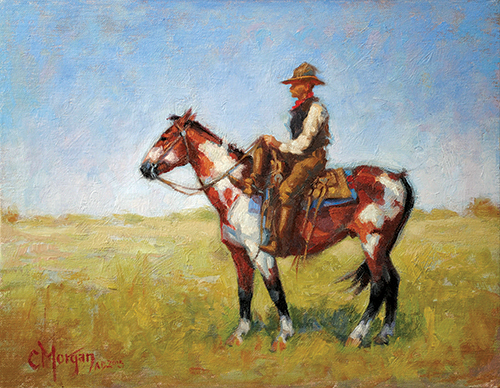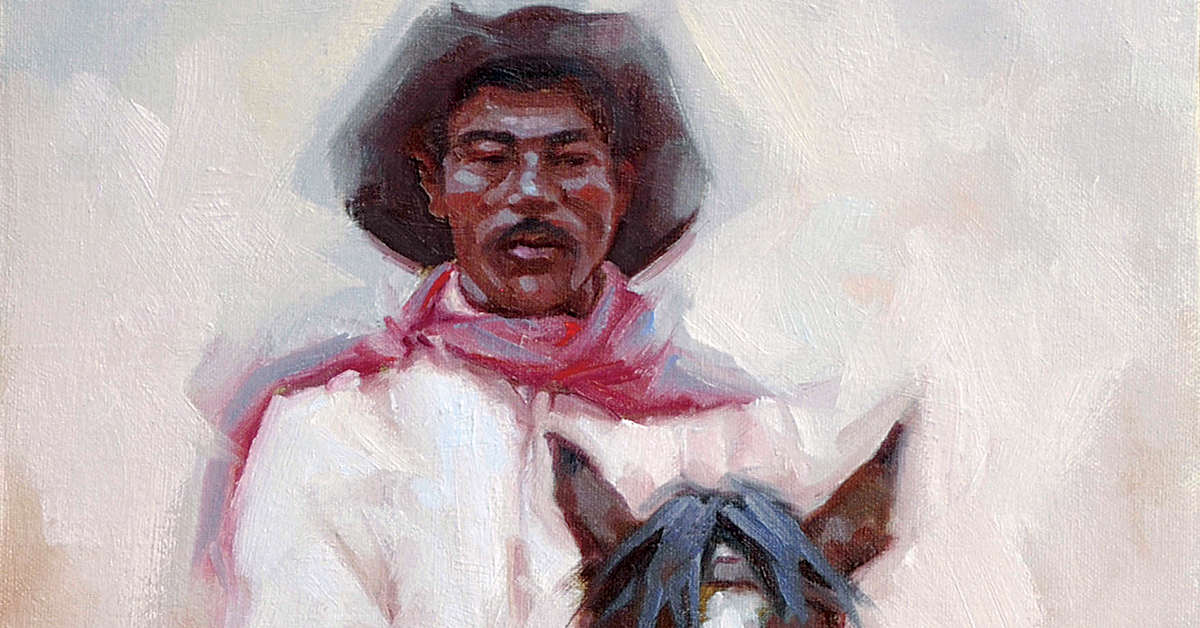Though historians and artists have generally overlooked black cowboys, Bill Pickett (1870–1932) certainly earned his share of attention. The subject of several biographies, the Texas-born cowboy, rodeo star, Wild West show performer and silent film actor has been honored with hall of fame inductions, statues, paintings and even a U.S. postage stamp. Among the most recent depictions of Pickett is the 14-by-11-inch oil on canvas Wrangler Memories #22, Bill Pickett, by Alabama artist Cecile W. Morgan.
“I had read somewhere that probably 20–25 percent of the cowboys in the Old West were African American,” Morgan says, “but there is scant information to be found about such a significant percentage of that population. Bill Pickett was one of the few African American cowboys recognized for his craft. He is actually credited with inventing the sport of bulldogging.
“The vintage photo I used for inspiration depicted a tough countenance—the classic ‘game face’ found on a seasoned contender. I wanted to honor that image by adding a limited color harmony in my painting.”

The portrait of Pickett is one of Morgan’s Wrangler Memories series of Old West renderings, based on historic photographs. Other sets pay homage to American Indians, buckaroos and cowgirls. “Because copyrights have expired on pre-1920 photographs, I can use these actual images of the actual West for inspiration,” Morgan says. “I look for images that speak to me.”
Opelika, Ala., some 7 miles northeast of Auburn, might seem an unlikely place to find a Western artist, but Morgan was born into a military family at Ardmore Air Force Base in south-central Oklahoma. “We moved often,” she says, “and I had lived in Oklahoma, France, Virginia, Britain, Turkey and Missouri before the eighth grade. My father retired to Alabama at that point to be a test pilot.” Morgan later studied painting and earned a degree in fine art.
The artist pulls images from both online and physical sources. “Many state archives have uploaded their images to the internet,” she says, “and many of these images find their way to Pinterest. I’ve created my own virtual museum. I also look for photographs in antique stores and estate sales.”
‘I can change the color of the horse to suit my color harmony and emphasize a part of what I see for composition’s sake, but that photo is truth from history. I have to trust it’
Morgan considers her in-depth research the next best thing to being there. “Even though my life directions have prevented me from actually living these experiences, they still resonate in my heart,” she says. “In an inexplicable way they’re a part of me. Do I romanticize them? Probably. But I admire those tough, gutsy cowgirls who did what they loved, even if it got them dirty or banged up. I’ve had a horse since I was 15 and can attribute pretty much every ache to a past wreck. But you get back on because you love every minute. I also admire the native peoples of this land, though I’m more careful in that series, as there’s much I don’t know.”
She wasn’t initially interested in the West, though. “It didn’t have much time to affect me before we left Oklahoma,” she says. “Maybe it was Roy Rogers when we returned stateside.” The artist, who often paints equine scenes and owns a horse named Doc, admits to another Western inspiration. “Probably it was Trigger.”
Morgan credits a Canadian portrait artist who moved to Alabama for much of her success. “Ronald Bayens really opened my eyes to what I should have learned at the university,” she says. “A whole new, unknown but glorious world began to unfold as I studied with him. Ron has since moved away, but I am forever indebted to him for exposing me to John Singer Sargent, Zorn, Sorolla and a plethora of old masters that blazed trails of bravura into the painting world.
“Thanks to my graphic design training, I was already familiar with the greats of the Golden Age of Illustration. These illustrators were every bit as great as the fine artists of their day. [Frederic] Remington, N.C. Wyeth and Dean Cornwell name just a few of the strong influences from that era. Contemporary influences abound and include Jill Soukup, Jason Rich and James Reynolds.”
Morgan herself leans toward smaller canvases. Her commissioned works range from 8-by-10 to 24-by-48 or 30-by-40 inches, while her research paintings are usually 8-by-10 to 12-by-24. She prefers working in oils. “They resonate with how I think and work,” she explains. “I find it to be very forgiving. If a painting turns into a train wreck, I can paint right over it with another image at a later date.”
Much of her research is visual, and she’s a stickler for authenticity. “When I find a hundred-plus-year-old photograph, I have to trust that photo,” she says. “I may take liberties in some areas design-wise, but I can’t change the integrity of the gear. I can change the color of the horse to suit my color harmony and emphasize a part of what I see for composition’s sake, but that photo is truth from history. I have to trust it.” WW
To see and learn more, visit DailyPaintWorks.com/artists/cecile-w-morgan-5669.





